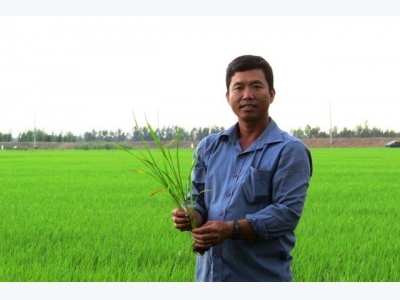Dong Thap farmer profits from thinking big

Nguyen Van Khanh in the middle of his vast field. Photo: baodongthap
Dong Thap (VNA) - Nguyen Van Khanh, 47, earns 3-4 billion VND (132,000-176,000 USD) a year from re-producing an exciting type of rice from Japan known as DS1. To do it, he had to acquire land from relatives and friends so that he can use mechanised farm equipment to handle the large cultivation area.
The Japanese strain of rice, researched for years, is soft, fragrant, very tasty and more productive than other strains, such as IR50404 which is hard, not so tasty and less productive. The concept has impressed rural and government authorities so much they are prepared to back it , seeing it as the start of a new era in national rice production which has been unchanged for centuries.
The Mekong Delta farmer from Dong Thap province’s Phu Cuong village in Tam Nong district has accumulated 120ha of land to grow the new strain of rice, also known as Japonica, which has been imported by the Agriculture Genetics Institute (AGP). The rice meets high quality standards for export.
Khanh said that fertile land in the Dong Thap region was famous for its vast length and breadth. A folk saying goes that it would take all day for a stork to fly over it. But rice cultivation in the delta has not changed much in several thousand years. Farmers continue to grow crops on tiny pieces of land that make it impossible to use motorised equipment, such as rice harvesters.
Khanh discussed the problem with his brothers and sisters and asked them to let him use all the land left by their parents to grow ĐS1 rice. After several days of discussions, they agreed to let him manage 80ha of land.
Khanh’s elderly brother Nguyen Văn Kha said: “We saw Khanh’s passion for rice growing, so we decided to transfer the right of using our land to him. Each year he pays us 18 million VND per hectare as rental.”
Khanh admitted he was initially worried about making a profit to pay them. "But my wife encouraged me to try. We borrowed money from our relatives, friends and banks to buy tilling machines and harvesters to handle such an immense pieced of land,” he said.
He travelled to the nearby province of An Giang to learn about the ĐS1 rice seeds, which is highly resistant to diseases and pests and can adapt to the alkaline soil in Dong Thap. He also built a rice storage shed and dredged out channels and a drainage system.
As a result, the first crop in 2012 produced between 6.2-6.5 tonnes of rice per hectare compared to the normal yield for Vietnamese rice of between 4-4.5 tonnes/ha. Already, several rice exporting companies have signed contracts with him to sell them the rice from 6,500 VND to 7,100 VND/kg.
“For each crop between 1,000- 1,1000, I earn a profit of between 3-4 billion VND,” Khanh said.
Thai Van Thanh, a neighbour of Khanh, said, “ I have my land near Khanh’s and we cultivated the same rice seed, but because he has more land, he has higher yield and quality, so many companies arrived to pay more for his special crop.”
By 2015, Khanh had accumulated a total of 120ha to grow Japanese rice, harvesting 10 tonnes per hectares. By July the same year, Secretary of the provincial Party Committee Le Minh Hoan made a tour to Khanh’s field, saying he appreciated the potential and prospective development of the model.
“You should learn more about business management and stimulate more farmers to follow your model to produce the Japanese rice and then set up a large business to reduce costs and create more profits for farmers,” Hoan told Khanh.
Khanh agreed with the provincial leader, saying he had plans to acquire 150ha of land to improve quality, reduce spending and increase profit.
He proposed the State improve bridges and expand roads to create better conditions for transporting farming materials and rice.
Nguyen Van Thanh, chairman of the Tam Nong district’s Farmers Association, said he highly valued Khanh’s rice cultivation methods. He said Khanh had created stable jobs for nearly 30 workers on a monthly income of between 5-7 million VND, and millions of VND for community charities.
Chairman of the Tam Nong district Nguyen Van Na said: “ This is a unique model which has been researched by relevant agencies and organisations so as to apply it into large-scale production from now to 2020 and years later. We aim to contribute our cultivating methods and experiences to Dong Thap province.
"We will also ask the Ministry of Agriculture and Rural Development to make a suitable policy for the country’s agriculture to help farmers escape from poverty.”
Related news
 Investment in high-tech agriculture growing
Investment in high-tech agriculture growing Agriculture in general and high-tech agriculture, in particular, have become attractive investment draws for domestic and foreign enterprises
 Organic rice production models to affirm Vietnam’s export status
Organic rice production models to affirm Vietnam’s export status Currently rice production occupies 54% of the total farm land in the region, contributing more than 90% of Vietnam’s rice for export and bringing in billions
 Vietnam’s pepper industry about to burst
Vietnam’s pepper industry about to burst Vietnam’s pepper farmers are on pins and needles as pepper prices continue to decline. The industry, once known for its high profit margins